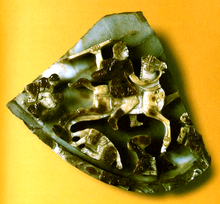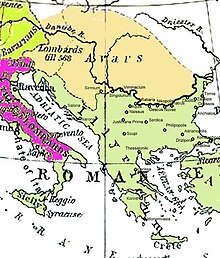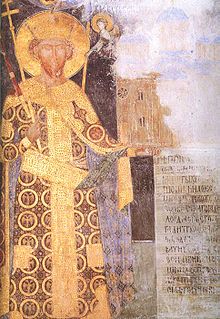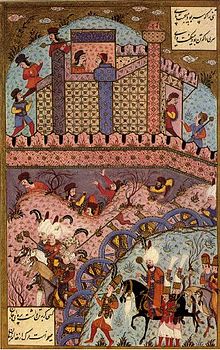History of Belgrade
The history of Belgrade goes back to ancient times . Founded by the Celts, the Romans named the city Singidunum . It became an important legionary camp on the Danube Limes and was a central defensive position against the barbarians until the beginning of the 7th century . During the Great Migration , the snatched Avars and Slavs the Byzantines the Kastron . The Slavic name Belgrade first appears in early medieval Christian sources in 878 . In the High Middle Ages it was a contested border town between Byzantium, Bulgaria and Hungary , a transit point for three crusades and, in 1402, the capital of Serbia for the first time . Belgrade flourished in the 15th century as an important late medieval cultural center and an important trading town on the northern Balkan Peninsula on the border with Central Europe. After the fall of Constantinople and the Turkish conquest of Serbia (1459), the strategically important fortified castle , which was completely renewed, became the focus of Ottoman expansion policy . The first siege was successfully repulsed in 1456, but the Ottomans finally conquered the city in 1521. After the Turks were driven out of Hungary in the Great Turkish War , Belgrade again became a central strategic theater of war and a heavily contested fortress city between the Ottoman Empire and the in the last quarter of the 17th century Habsburg Monarchy . During the Serbian uprisings , Belgrade became the capital of Serbia at the beginning of the 19th century and, after the First World War, it became the capital of Yugoslavia until the end of the 20th century .
Prehistory and early history
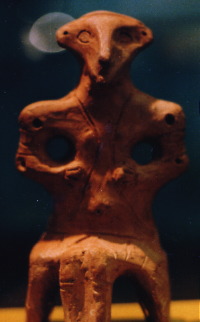
Archaeological finds are made up to 5000 years BC. Dated to the Neolithic . In the suburbs of Belgrade are the Neolithic settlement mounds of the Starčevo and Vinča cultures .
Antiquity
Roman period

The first name of a settlement that has been preserved in writing is the Roman mention of a probably originally larger Celtic settlement around 279 BC. BC The Romans called the settlement Singidunum . The name probably meant round fortress or round city and was probably derived from the Celtic. Singidunum was founded by the Romans around 86 BC. Conquered. They expanded the city as a fortress, but for a long time it remained in the shadow of Sirmium , which was the capital of one of the four prefectures of the Roman Empire.
The city was incorporated into the province of Moesia superior (capital Viminatium , today's Kostolac ) and becomes a garrison town on the Danube limes . On the opposite side of the Sava was the city of Taurunum , today's Zemun .
In the year 86 AD Domitian moved the Legio IV. Flavia Felix to Singidunum parallel to the strengthening of the imperial borders against the Dacians . This meant a significant upswing for the city. At the site of today's fortress , the Roman castrum stands in the 2nd century as a classic rectangular complex with the aspect ratio 560 × 350 m, which extends from the upper town of the fortress of Belgrade to today's Pariska Ulica . A bridge over the Save also connected Singidunum and Taurunum at the time.
At the beginning of the 2nd century, Trajan (105-106) defeated Dazien with the participation of the Legio IIII Flavia Felix , who had participated in the campaigns since 88 and also took over parts of the road construction north of the Danube. With the formation of the province of Dacia , a time of peace began for Singidunum. In the middle of the 2nd century, Emperor Hadrian relocated the Legio IIII Flavia Felix back to Singidunum and granted the city the status of a municipality with greater administrative freedom.
With the attacks of the Goths, the Romans left 268 Dacia. Aurelian therefore relocated all legions to the south bank of the Danube and reorganized the region by forming the province of Dacia ripensis . The Legio IIII Flavia Felix took part in at least one campaign against the Parthians in the 3rd century , which is documented on a tombstone in Kyrrhos in Syria .
The first half of the 4th century was again a period of peace: the city received the status of a Roman colony, which further reinforced its autonomy. The future Emperor Jovian was born here in 332. An inscription of around 300, dedicated to the genius of the fourth Flavian Legion, testifies to the continued presence of Flavia Felix in Singidunum. The fourth Flavian is documented until the middle of the century and was disbanded before the end of the century. With the division of the empire in 395 under Theodosius I , Singidunum came to Eastern Europe, from which the Byzantine Empire emerged .
During the time of the Roman Empire, Singidunum was an integral part of the defensive fortifications on the Danube Limes. The strategic location of the city and castrum on the via militaris , which led from Sirmium ( Sremska Mitrovica ) via Viminatium ( Kostolac ), Trimontium ( Plovdiv ) to Constantinople , determined the history of Singidunum until the beginning of the 7th century. The forts Mutatio ad Sextum ( Mali Mokri Lug ), Castra Tricornia ( Ritopek ) and Mutatio ad Sextum Militare ( Grocka ) in the vicinity of Belgrade defended the military road. Another road connection connected the mines on Avala , Kosmaj and Rudnik .
The military town of Singidunum was supplemented by an important civil town with the settlement of legion veterans in the lower town. Notable remnants of the imperial period have been found all over the area (tombs, monuments, sculptures, ceramics, coins). Parts of the street system still ran according to the ancient scheme and can be recognized by the orientation of the streets Uzun Mirkova , Dušanova and Kralja Petra . At Studentski Trg ("Student Square") stood the ancient forum with a rectangular floor plan. Parts of the Roman thermal baths were uncovered there in the 1970s.
Great Migration and Byzantine Period
In the 5th century, the Western Roman Empire disappeared as a power factor, which meant a series of invasions of the Balkan Peninsula by Germanic , Mongolian , Slavic and Turkish peoples for the remaining Eastern Roman Empire . In 441 the Huns attacked Singidunum and almost completely destroyed the place. In 454 the East Romans recaptured the city, but after 470 it fell to the Ostrogoths , 488 to the Gepids and Sarmatians and 504 again to the Goths. In 510 Singidunum came back to the Byzantine Empire by treaty . In 512 the Byzantine Emperor Anastasios I settled the Germanic Heruli to ward off the Gepids .
Through the Restauratio imperii operated by Justinian I , the emperor fortified the Danube border in 535 through a large-scale, purely defensive fortress construction program on the lower Danube, in order to take the offensive on the fronts against the Vandals in North Africa, the Ostrogoths in Italy and the Persian Empire go. Justinian renewed the fortification of Singidunum, which was moved to the center, in the form of a significantly reduced, but with strong walls fortified Byzantine castron within the old abandoned legion camp (Castra) , which was achieved in particular by a further staggering of Kastra, the newly built, political and ecclesiastical Organization of the new administrative center of Justiniana Prima ( Caričin Grad ), serving the region, was supposed to protect and prevent incursions to Moesia , but became a waste of time when the Slavs took over the Balkans, which was no longer prevented .
The well-fortified Kastron Singidunum , already resembling a medieval castle, formed the nucleus of the medieval city, which, with the exception of the newly built and fortified lower town of the fortress of Belgrade until the beginning of the 15th century under Stefan Lazarević, also formed until the beginning of the 16th century did not grow beyond the Justinian limits.
With the last great migration of the Avars, the Slavs immigrated as allies into the Pannonian Plain and in 582 conquered the strategically important city of Sirmium . In 584 the Kastron Singidunum also fell , with which the defense of the entire Byzantine Danube border collapsed. It was not until Emperor Maurikios , beginning with his accession, undertook a 20-year and finally successful defensive battle against the Avars and Slavs. In 592 his troops were able to recapture Singidunum. Subsequently, the Avars were pushed back north of the Danube line. The reconquest of the Balkans by the armies of the Romans was also reinforced by the subsequent campaigns under Phocas , but with the withdrawal of the Roman units to Asia Minor under Herakleios , the Roman supremacy on the Balkan peninsula collapsed completely. The following rapid conquest of the Slavs took place from 612, but a Roman fortress commander stayed in Singidunum until 625.
middle Ages
Early middle ages
Slavic settlement
In 630 Singidunum was conquered by the Slavs and the region as well as large parts of the Balkan Peninsula were Slavicized. After this conquest, 200 years followed without any historical mention of the fate of the city. With the invasion of the nomadic Proto-Bulgarians from Asia, the name Alba Bulgarica appears in Latin sources , which indicates the current balance of power in the region at that time. The name Beograd ( štokavian since 1400, previously with silbenschließendem - l : Bel -grad) established was locally since the great migration of Slavs the early 7th century. It is documented for the first time in 878 in a letter from Pope John VIII to the Bulgarian Knjaz Boris I : episcopus Belogradensis . A scholarly form was Alba Graeca . This name indicates the time of the Byzantine ( Graeca - Greek) supremacy in this region. In Byzantine sources, the city was referred to as Veligradon - a slight modification of Belgrade. The name probably goes back to the light color of the limestone used to build the fortification, while the Avar name has historically been lost.
Between Hungary, Byzantium and Bulgaria
For the next four centuries, Belgrade became a constant strategic bone of contention between the Byzantine Empire, the Kingdom of Hungary and the First Bulgarian Empire .
A few dates mark this warlike period: In 896 the Hungarians took over Belgrade. In 971 the Byzantines conquered the city. The Bulgarian Tsar Samuil conquered the city in 976. In 1018 Basil II reintegrated Belgrade into the Byzantine Empire and in 1096 the Hungarians destroyed the city, but the Byzantines retained control.
High Middle Ages
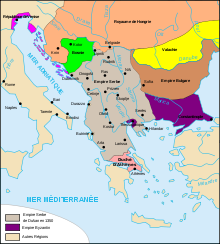
Crusades and Byzantine renewal of the Danube fortifications under Manuel I.
After Jerusalem fell into the hands of the Seljuks in 1076 , the first crusades began soon after , which also led through Belgrade in 1096 and 1147. In 1127 the Hungarian King Stephan II destroyed the city and used the stones to build a fortification in Sirmia opposite Belgrade in Zemun (the ancient Taurunum Castle ) . During the campaigns of the Byzantine Emperor Manuel I from 1149 to 1150 with the aim of ending the uprising of the Serbian Grand Župan Uroš II in Razia , the Byzantine Empire regained the initiative on the Balkan Peninsula and also won against the Hungarians in two Wars (1151–1153 and 1163–1168) got the upper hand. In 1154 Manuel I destroyed Zemun and then expanded the fortification in Belgrade in the form of a deltoid fort. The secured Danube border allowed the Byzantines to launch an offensive against Hungary from here. The territorial disputes over supremacy in the Balkans between Manuel I and Géza II and his successor Stephan III. culminated in the battle of Sirmium , where Hungary was defeated on July 8, 1167 by the emperor and the allied Raszier 60 km from Belgrade. This decided the Byzantine-Hungarian War and the entire western Balkan Peninsula was under Byzantine possession. For the first time in centuries, Belgrade played a decisive role in defending the borders of the Eastern Roman Empire. At the time, the Arab geographer and cartographer al-Idrisi described Belgrade as a city "well populated and handsome".
With the Byzantine defeat of Myriokephalon , the Hungarians were able to threaten the border again and in 1182 they conquered the city again, but had to return Belgrade to the Byzantines in 1185. In 1189, Emperor Friedrich Barbarossa , leader of the third crusade , was in Belgrade. The Christian troops plundered Zemun and also destroyed Belgrade. After Byzantium fell out of power as a result of the Fourth Crusade after 1203, open fighting began for Belgrade, which fell to the Bulgarians in 1230 and to the Hungarians in 1232. For the major part of the High Middle Ages they retained control of Belgrade. Only with the emergence of the Nemanjiden Empire was Belgrade claimed by a Balkan country again.
Between Serbia and Hungary
The first Serbian king to rule the city was Stefan Dragutin , who as a vassal of the Hungarian king Ladislaus IV. Was able to build his own kingdom in the north of the then Serbian empire from 1282 to 1316 in competition with Stefan Uroš II Milutin . In 1284 he made Belgrade the capital of the Kingdom of Srem and also achieved that the area of Sirmia north of the Sava came to his territory. After his death in 1316, Belgrade fell to his younger brother Stefan Milutin, but in 1319 the Hungarians under Charles I were able to wrest the city from him after the battle in the Mačva . From then on, the territory of Srem, Mačva and Belgrade was a territorial point of contention between Hungary and Serbia. King Stefan Uroš III. Dečanski and in particular Tsar Stefan Uroš IV. Dušan (1331-1355) testified to their claim to the territory. Stefan Dušan, the most powerful ruler of medieval Serbia , briefly annexed Belgrade to his rule after he was able to repel Charles I's incursion and the Hungarian king was wounded in the process. But in the end Belgrade stayed with Hungary. Only under the successors of the Nemanjids did the city become a central part of the Serbian medieval empire.
Late Middle Ages
Capital of the Serbian despotate
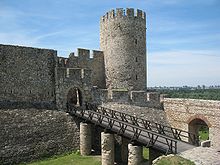

After the battle on the Blackbird Field, the Serbian center of power increasingly shifted to the north. By Stefan Lazarevic (1389-1427) Belgrade was also the first time as Serbian due to its strategic location and the safe distance from possible invasions Ottoman royal seat chosen. During this time, the court of Stefan Lazarević in Belgrade became a refuge for displaced Orthodox Christians from the countries of the Balkan Peninsula besieged by the Turks, who wanted to escape the expanding rule of the Ottomans or who had fled from persecution and oppression. The resulting cosmopolitan Orthodox population led by partially highly educated refugees from the crumbling southern Balkan countries ( Bulgaria , (1393 fell Veliko Tarnowo , 1396 Vidin ), Macedonia (1395 death of Konstantin Dragaš and Marko Kraljević ), Kosovo (1397 died Vuk Branković )) an emphatic flowering of literature and art ( Palaiological Renaissance ), which led to the most important late medieval writing school (“Belgrade Writing School”) in the capital of the Serbian despotate next to the Manasija monastery . Belgrade was one of the most important cities on the Balkan Peninsula at this time.
Thanks to the income from the trade in ores and precious metals and the flourishing trade with the Republic of Ragusa, the resurgent Serbia prospered under Stefan Lazarević, so that he was able to generously expand his residence. Evidence of the renewal of the city, especially in the expansion of the fortress of Belgrade , is the division into upper (residence) and lower (civil) town, which was retained until the late 19th century. The Despot's Gate , which still bears the name of its builder, has survived from this period . On the other hand, all religious (city cathedral, so-called cathedral of the Belgrade Metropolitan ) as well as profane (castle of Stefan Lazarevic) buildings were destroyed. It is believed that Belgrade had around 40,000 to 50,000 inhabitants during this period.
Among the important scholars and writers who lived at the court of the despot was one of the last universal scholars of the Byzantine Empire, Konstantin Kostenezki , as well as Grigory Camblak . In Konstantin Kostenezki's hagiography, The Life of Despot Stefan Lazarević ( Житија деспота Стефана Лазаревића ), Belgrade is referred to as the new Jerusalem and Constantinople because of its beauty and prosperity .
Return to Hungary and first siege of Belgrade by the Turks


During the time of Stefan Lazarević's subsequent despot ićurađ Branković , Belgrade was returned to Hungary. The Ottomans conquered most of Serbia with the exception of the new capital Smederevo by the beginning of the second half of the 15th century , while Belgrade remained under the rule of the Hungarian King Sigismund . For the Ottomans, Belgrade represented a major obstacle on the way to Central Europe , which from their point of view absolutely had to be conquered. Finally, the Ottomans attacked Belgrade on July 4, 1456, which led to the siege of Belgrade . The Christian army, led by Johann Hunyadi , finally defended Belgrade with success.
During the Hungarian rule, the population structure and the appearance of the city changed. The city gradually fell into stagnation. The displaced Serbian population lived on the outskirts and had no access to the upper town. The Hungarian king increasingly settled the Hungarian population and expanded the influence of the Catholic Church. Due to the successful first defense of the city against the Turks, with the exception of small reinforcements of the upper town through the Zindan Gate and the construction of the Nebojsa Tower in the lower town, no significant reinforcement was made at the fortifications, which was the case with the second attempt by the Ottomans, Taking Belgrade should prove to be a fatal mistake, as Sultan Suleyman I would also use heavy artillery this time and the castle built against edged weapons from the time of Stefan Lazarević was not intended for this.
Modern times
Belgrade between Orient and Occident
Turkish conquest 1521

The Ottoman army under Suleyman I finally conquered Belgrade from the Hungarians on August 28, 1521. The Ottomans destroyed and pillaged the city in order to repopulate it after the conquest. The city was developed into a modern and oriental city. Belgrade also served the Ottomans as the most important base for their campaigns against the West. By 1571 there were around 27 villages around the city. In 1594 the city experienced a great uprising by the Serbs, which the Ottomans forcibly suppressed by setting fire to several churches and burning the body of Sveti Sava on the Vračar hill . It was precisely because of this event that Vračar was chosen as the place where the St. Sava Cathedral was to be built.
For the next 150 years, Belgrade was a relatively quiet city with an important trade and transport function. Belgrade was also the seat of the Sanjak Smederevo , which had been moved from Smederevo to Belgrade. At that time the city attracted many merchants, traders and residents, including Turks , Armenians , Greeks and Roma . According to reports by the Ottoman traveler Evliya Çelebi , who was in Belgrade in 1660, Belgrade had about 98,000 inhabitants at that time, of which 21,000 were non-Islamic. At that time the city experienced its greatest boom under the Turks and became the second largest city in the Ottoman Empire after Constantinople . Public baths were built and many new mosques were built. Islamic architecture shaped the image of the city back then. At the end of the 16th century, Belgrade was considered one of the most beautiful cities in the Ottoman part of Europe because of its size and beauty. The largest mosque in Belgrade was the Batal Mosque . Many travelers compared it to Hagia Sophia . The Batal Mosque was located on the spot where the Serbian Parliament is today. Next to her was a cemetery where respected and respected Ottomans were buried.
Turkish Wars
After the successful second defense of the Turks in front of Vienna in 1683, the Holy League was able to push the Ottomans back behind Belgrade in the Great Turkish War . Under the command of Max Emanuel , Elector of Bavaria , the siege of Belgrade began in early August 1688. Only one month later, on September 6, 1688, the city was captured with enormous losses on both sides. But as early as 1690 the Ottomans recaptured the city. The Habsburgs were especially through the military skill of Prince Eugene of Savoy in the Venetian-Austrian war against the Turks in the Battle of Petrovaradin rid of the Ottomans Hungary and on August 18, 1717 Key fortress Belgrade during the Battle of Belgrade conquer by unexpectedly not land , but attacked from the water using a pontoon bridge . This victory is immortalized in the song Prinz Eugen, the noble knight . The subsequent Peace of Passarowitz (1718) enlarged Austria to include northern Serbia , Banat and western Wallachia and made the Habsburg Empire a major European power, which until 1918, as part of the Austrian sphere of interest, was the main actor in all political crises in the Balkan Peninsula.
The medieval castle complex of Belgrade was redesigned as a modern main fortress against the Ottomans after Vauban by 1739 and new entrances to the city, such as the Stambol kapija , were built. After the repeated loss of the city in the Peace of Belgrade in 1739 after the Russo-Austrian Turkish War , all work carried out on the fortress was blown up, leaving the Turks with an unusable facility.
The Austrians took Belgrade again briefly in 1789, but contractually lost the city again in the peace treaty of Swishtov in 1791. Due to these constant battles for Belgrade, the Ottomans called it Dar Ul Jihad , which meant something like house of war.
During the period of the Great Turkish War from 1683 to 1699, there was considerable population migration in almost all of south-eastern Europe and particularly in Hungary and Serbia. Belgrade lost most of its 100,000 inhabitants as early as 1688. The great wave of Serbs emigrating from Kosovo under the leadership of the Serbian Patriarch Arsenije IV. Jovanović out of fear of reprisals and with the help of the Habsburgs to today's Vojvodina and Slavonia took place not least to repopulate the devastated new Habsburg regions. The strategic layout of the military border was also protected in the Banat section by the settlement of Serbs as fortified farmers. From 1690 until the military border was dissolved in 1882, Belgrade remained the focus of this cordon sanitaire .
Serbian Wars of Liberation
In 1804, the Serbs began the so-called first uprising against the Ottomans, more precisely against the Janissaries , who had risen to become the powerful and dominant warrior caste in the Ottoman Empire and who acted more restrictively than the previous usual style of leadership, deprived the Serbs of their previously granted autonomy in the Ottoman Empire and lowered their leading heads and executed them. They made Karađorđe their leader , who, notorious for his ruthlessness towards the Ottomans, but also towards the converted Serbs, showed himself to be the most determined enemy of the Ottoman yoke, which earned him the Turkish nickname Kara for black Đorđe (Georg). During the uprising in Belgrade, many mosques were destroyed, while others were converted into stables for pigs. One mosque was converted into an Orthodox church and the remaining ones were given to Muslim women to live. The insurgents held the city in their hands from January 8, 1806 until 1813, but the Ottomans recaptured it.
When the Ottomans returned to the city, some mosques were restored, but as early as 1815 the Serbs under Miloš Obrenović dared a second uprising . They fought for an autonomous principality , and Belgrade came under their administrative sovereignty. An Ottoman regiment stayed in the Belgrade fortress. According to a report from 1836, there were 16 mosques in Belgrade at the time. With the departure of the Ottomans from the city in 1867 (most of them were of Slavic origin), a new era began in Belgrade. Felix Philipp Kanitz once said when he was in Belgrade: "If you suddenly heard an explosion, then it was again the destruction of a mosque that disturbed the cityscape." The only remaining mosque in Belgrade today is the Bajrakli Mosque in the district Dorćol.
Modern
The dawn of modernity in Serbia
On April 18, 1867, Prince Mihailo Obrenović forced the last Ottoman regiments to leave the principality with their belongings, and Belgrade was solemnly consecrated as the free Serbian capital. After 346 years of rule, the Ottoman period in Belgrade was over. The prince moved the capital from Kragujevac to Belgrade. When Serbia got its full independence from the Ottoman Empire with the results of the Berlin Congress in 1878, Belgrade developed into one of the key cities in the Balkans and began to expand dramatically. But even with the construction of the railway line to Niš , the conditions in Serbia remained the same. H. as in the other agricultural countries in the area. Belgrade only had 69,100 inhabitants in 1900 . With the overthrow of the Obrenović dynasty from the Serbian throne in 1903, the population increased steadily. As early as 1905, Belgrade had over 80,000 inhabitants, and before the First World War (1914) it was around 100,000.
First World War
Gavrilo Princip's assassination attempt on the Austro-Hungarian heir to the throne Archduke Franz Ferdinand and his wife Sophie in Sarajevo on June 28, 1914 was the occasion for the July crisis , which in its course triggered the First World War . Most of Austria-Hungary's later Balkan offensives against Serbia took place near Belgrade. Belgrade was officially attacked on July 29, 1914, one day after Austria-Hungary declared war on Serbia, under General Oskar Potiorek . The Central Powers conquered the city very quickly. However, the Serbian troops under Marshal Radomir Putnik recaptured the city on December 15 of the same year. A large part of the city was destroyed in long battles and on October 9, 1915, Belgrade came back into the hands of the Central Powers. The city was liberated on November 5, 1918 by Serbian and French troops under the command of Marshal Louis Franchet d'Espérey and the Serbian Crown Prince Aleksandar Karađorđević . Together with the French troops, the Serbian troops liberated Serbia and advanced as far as Subotica , which was then in Austria-Hungary. With the Treaty of Trianon , the Kingdom of Hungary lost more than two thirds (from 325,411 km² to 93,073 km²) of its imperial territory. This also affected Subotica and so the city came under the Serbian flag. Subotica was the largest city in the kingdom at that time after it became part of Serbia, but Belgrade began to grow rapidly.
After the war, Belgrade became the capital of the newly established Kingdom of Serbs, Croats and Slovenes (renamed Kingdom of Yugoslavia from 1929). The kingdom was divided into Banovinas in 1929 and Belgrade formed a separate administrative unit together with Zemun and Pančevo .
During the interwar period, the city experienced real economic and population growth. A significant modernization of many destroyed buildings followed. The population grew to 239,000 (1931) inhabitants (including Zemun, which formerly belonged to Austria-Hungary), in 1940 it was 320,000. The population growth rate averaged 4.08% per year between 1921 and 1948. The first airport was opened in Belgrade in 1927 and the first radio station started operating in 1929. The Pančevo Bridge, which spans the Danube , was built in 1935.
Second World War
Air raid and occupation time

On March 25, 1941, Prince Regent Paul of Yugoslavia signed the Tripartite Pact , which led to considerable demonstrations in Belgrade and resulted in the overthrow of the previous aristocratic elite. As a result, on April 6, 1941, the Axis powers attacked the Kingdom of Yugoslavia without warning or a declaration of war. Bombardment by the German Air Force caused serious damage to Belgrade, including a. the National Library was destroyed by fire and priceless cultural assets were lost. Thousands of Belgrade residents lost their lives to the bombings and the inhumane occupation. On April 12, 1941, the city was occupied by German SS units. First an advance guard under Fritz Klingenberg with only 6 men managed to hand over the city to the Germans, then in the evening it was occupied by Kleist's tank group . Yugoslavia was then occupied by German, Italian, Bulgarian and Hungarian troops. Today's area around Zemun and all of Syrmia was annexed to the independent state of Croatia , which was an important ally of the Germans at the time. Belgrade was named the seat of occupied Serbia, which was ruled under a puppet government of Milan Nedić .
In the summer and autumn of 1941, German attacks on the civilian population followed. Under General Franz Böhme , the German military governor for Serbia, German soldiers massacred the Belgrade population, especially the Jews. Böhme rigorously enforced his rule that 100 Serbs or Jews would be shot for every German soldier killed.
Soviet liberation and victory of the partisans
Belgrade was bombed by the Allies on April 16, 1944. The bombing killed 1,600 people. Both bombardments (April 1941 and April 1944) fell on the Christian Orthodox Easter. On October 20, 1944, Belgrade was finally liberated by the Red Army and the Yugoslav People's Liberation Army during the Belgrade Operation . On November 29, 1945, Marshal Josip Broz Tito proclaimed the People's Federal Republic of Yugoslavia in Belgrade (renamed the Socialist Federal Republic of Yugoslavia on April 7, 1963 ).
Cold War
From 1944 to 1991 Belgrade was both the capital of the non-aligned socialist Yugoslavia and the republic of Serbia. New Belgrade ( Novi Beograd ), a modern settlement at the confluence of the Sava and Danube opposite the old town, was expanded.
Belgrade hosted the founding conference of the non-aligned states from September 1 to 6, 1961 . The CSCE's first follow-up conference was held from October 1977 to March 1978 in the Sava Centar , which was set up specifically for this purpose .
With the adoption of a new Yugoslav constitution in 1974 and the associated strengthening of the federal elements as well as the formation of the autonomous provinces of Kosovo and Vojvodina, protests broke out on the streets of Belgrade (the so-called national moment ). The protests came from the predominantly Serbian population in Belgrade, who questioned Tito's leadership style more and more during this time.
Bombardment in 1999
With the collapse of the Second Yugoslavia in the 1990s, Belgrade became the capital of the newly formed Federal Republic of Yugoslavia .
On March 24, 1999, in the course of the Kosovo war, NATO began air strikes against the Federal Republic of Yugoslavia, which also affected Belgrade. In addition to the 203-meter-high Avala television tower , which was built on Mount Avala in 1965 and was also accessible to tourists, numerous government buildings such as the Ministry of Defense and the police headquarters were also destroyed. In addition, buildings of television or radio stations, killing 16 RTS employees , as well as several civilian facilities such as electricity and water works, telephone lines, bridges and roads were affected by the attacks. Schools, hospitals and residential buildings as well as the embassy of the People's Republic of China were hit , which caused a scandal. In individual places in the cityscape, ruins of the war can still be seen, which were neither removed nor rebuilt.
Transition to democracy
On October 5, 2000, angry citizens who joined the protests of the student movement OTPOR overthrew the regime of Yugoslav President Slobodan Milošević in Belgrade , largely peacefully . The parliament building of the Federal Republic of Yugoslavia was set on fire by the crowd.
From February 4, 2003 to June 3, 2006, Belgrade was the main administrative seat of the State Union of Serbia and Montenegro and has been the capital of the Republic of Serbia since the breakup of Montenegro .
literature
- Hans-Joachim Böttcher : The Turkish Wars in the Mirror of Saxon Biographies, Gabriele Schäfer Verlag Herne 2019, ISBN 978-3-944487-63-2 , pp. 145–157 (The First Conquest of Belgrade 1688).
Individual evidence
- ^ History of Belgrade
- ^ The Byzantine Period , Official Site of the City of Belgrade
- ↑ Official page for naming
- ↑ cf. Michael Witby, The Emperor Maurice and his Historian - Theophylact Simocatta on Persian and Balkan Warfare. Oxford 1988., p. 187
- ↑ Explanation of the Latin name
- ↑ page 83
- ↑ La Géographie d'Al Idrissi (avec carte interactive de la Méditerranée au). In: Exposition de la Bibliothèque nationale de France. Retrieved March 15, 2014 (French).
- ↑ Османско-мађарски ратови: Опсада Београда 1456, Том Р. Ковач (- {Historynet.com} -) ( Memento of the original from June 26, 2007 in the Internet Archive ) Info: The archive link was inserted automatically and has not yet been checked. Please check the original and archive link according to the instructions and then remove this notice.
- ↑ a b c d e f Abdulah Talundžić, Džamije u Beogradu on most.ba
- ↑ Духовни смисао Храма Светог Саве на Врачару - Амфилохије Радовић, Епископ банатски ( Memento from February 12, 2009 in the Internet archive )
- ↑ a b Град Београд - Историја (Турска и аустријска владавина)
- ↑ Batal-džamija- najveća i najlepša GRAĐEVINA
- ↑ Српски конгрес уједињења - Тајне поруке Светог Саве ( Memento from October 23, 2007 in the Internet Archive )
- ↑ a b Град Београд - Историја (Ослобађање Београда)
- ↑ Град Београд - Историја (Престоница Србије и Југославије)
- ↑ Статистике - Југославија ( Memento of the original from July 22, 2004 in the Internet Archive ) Info: The archive link was automatically inserted and not yet checked. Please check the original and archive link according to the instructions and then remove this notice.
- ↑ Католичка енциклопедија - Београд и Смедерево
- ↑ Индустрија и урбани развој Београда - Драган Петровић (Индустрија, 2001 књига 21, Бр 1-4, 87-94 стр..) ( Memento of 4 February 2008 at the Internet Archive )
- ↑ ISBN 86-17-09287-4 : Kosta Nikolić, Nikola Žutić, Momčilo Pavlović, Zorica Špadijer: Историја за трећи разред гимназије, Belgrade, 2002, pg. 144
- ↑ Dragan Petrović: Industrija i urbani razvoj Beograda Archived from the original on August 8, 2007. Info: The archive link was automatically inserted and not yet checked. Please check the original and archive link according to the instructions and then remove this notice. (PDF) In: Industrija . 21, No. 1-4, 2001, ISSN 0350-0373 , pp. 87-94. Retrieved July 10, 2007.
- ↑ Twentieth Century - Innovations in Belgrade . Serbia-info.com (Government of Serbia website). Archived from the original on July 5, 2008. Retrieved July 21, 2007.
- ^ Rolf-Dieter Müller : The bombing war 1939-1945. Links Verlag, Berlin 2004, ISBN 3-86153-317-0 , p. 86.
- ^ Richard L Rubenstein, Roth, John king: Approaches to Auschwitz: The Holocaust and Its Legacy . Westminster John Knox Press, 2003, ISBN 0-664-22353-2 , p. 170.
- ^ History of Belgrade in Socialism
- ↑ Timeline of NATO air strikes
- ^ Transition to democracy
